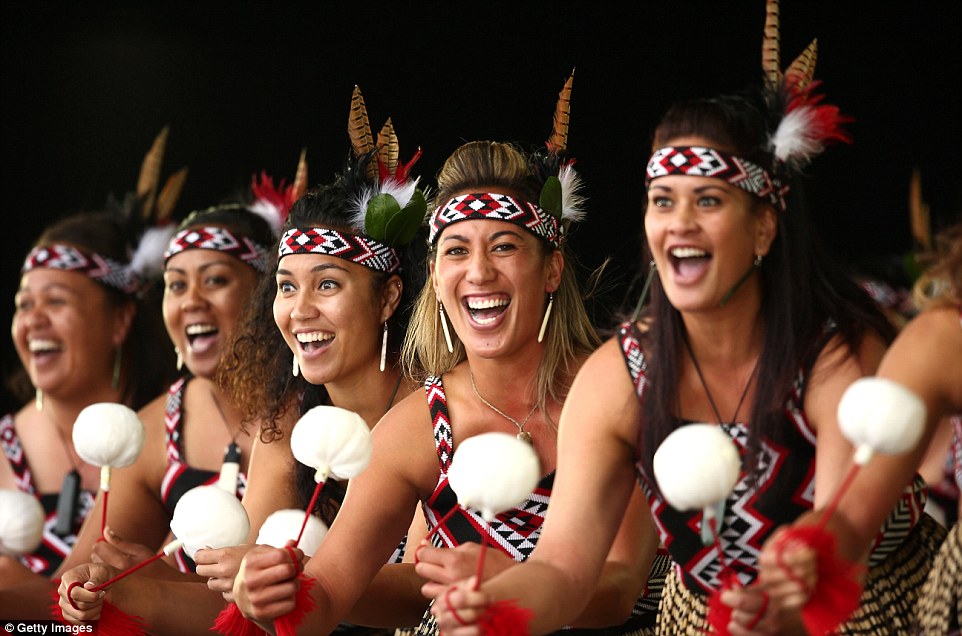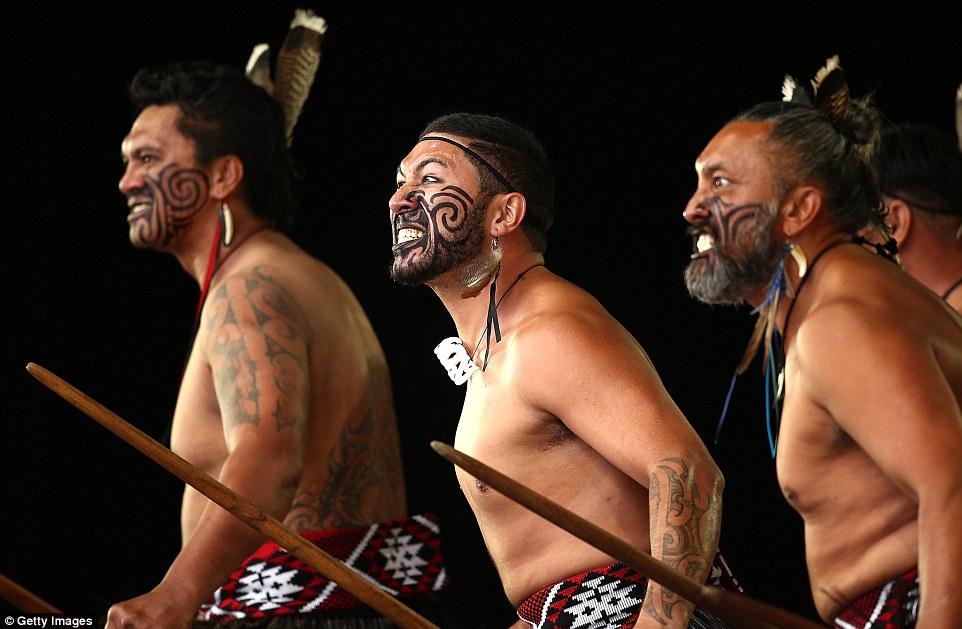Intricate costumes, elaborate face and body tattoos, and traditional Maori tribal dances: Inside New Zealand's biennial National Kapa Haka Festival
- This year, 30,000 performers and supporters have come together for the four day festival in Christchurch
- Celebrating traditional Maori performing arts, 45 teams will compete to be named national kapa haka champion
- Each team is judged based on their choreography, chants, poi demonstration and elaborate costumes
Colourful costumes, face tattoos and impressive dance moves... these are just a few of the things spectators will see during the elaborate performances of the Te Matatini National Kapa Haka Festival.
The biennial event, which celebrates traditional Maori performing arts, is currently taking place at Hagley Park in Christchurch, New Zealand.
This year, 45 teams from New Zealand and Australia are showcasing their talents and competing for the title of national kapa haka champion.
Scroll down for video

Every two years, thousands of traditional Maori performers come together to showcase their talents at the National Kapa Haka Festival

This year, the four-day competition is being held in Hagley Park in Christchurch, New Zealand, and will see 45 teams compete for top prize

Members of the Te Kapa Haka o Ngati Ranginui from Tauranga (pictured) are just one of many teams to perform this year
From March 4 through March 8, thousands of kapa haka performers will perform in a culmination of years of passionate commitment, dedication and hard work.
The competition itself is broken down into three pools: Te Ihu, Te Haumi and Te Kei.
The three teams that receive the highest combined marks from each pool will compete again, against each other in the finals.
Judges will then determine the new Toa Whakaihuwaka, the overall aggregate winner, from those final nine teams.

From Manawatu, members of the Te Tu Mataora team are clad in striking turquoise blue and purple costumes

Each team will compete in one of three pools, with the three top finalists from each being moved onto the semi-finals

Members of Tu Te Maungaroa from Wellington showcase elaborate face and body tattoos on their arms, legs and cheeks


A man from the Te Tu Mataora team (left) and a man from Te Kapa Haka o Ngti Ranginui (right) dance accompanied by traditional props

An integral part of each performance is the poi demonstration, as seen here by the Te Kapa Haka o Te Whanau-a- Apanui from Opotiki


The performance of the team's male and female leaders are also judged by particular criteria. Pictured: male Te Tu Mataora members jumping

Of the nine teams that make it to the finals, judges will then determine a new Toa Whakaihuwaka, the overall aggregate winner
The festival begins with a powhiri, where performers, guests and visitors are welcome by the local hosts.
Beginning on March 5, the competition pools began their initial rounds of performances.
Kapa haka teams must perform six disciplines within their piece: whakaeke (a choreographed entry), moteatea (a traditional chant), poi (a demonstration of a light ball swung on the end of a rope), waiata-a-ringa (an action song), haka and whakawatea (exit).
During each team's 30 minute performance, each discipline must be delivered in a perfect, polished manner.

Kapa haka teams must perform six disciplines during their piece, including a choreographed entry, a traditional chant and an action song

Each performance is 30 minutes in length and judges expect each team's delivery to be perfectly polished

For spectators who don't speak the local tongue, real-time English translations are available as each team takes to the stage

Several female members of Te Kapa Haka o Ngati Ranginui from Tauranga show off facial expressions as noteworthy as their movements

A male member of Tuhourangi-Ngati Wahiao from Rotoura boasts exceptionally intricate facial tattoos during a performance

The festival, which is now in its 22nd year, first began in 1972 and attracts performers and viewers from all around New Zealand and Australia

Another important part of the traditional Maori war dance is poi: a demonstration of a light ball swung on the end of a rope

As well as performances, spectators can also sample traditional Maori delicacies, shop for arts and crafts and take in cultural exhibitions
Dancers and their teams are also judged on their costumes and the performance of their female and male leaders.
And for those who don't speak the local tongue, English translation services are available in real-time as the performance unfolds on stage.
The festival is now in its 22nd year, attracting over 30,000 performers, supporters and visitors, after having first began in 1972.
As well as performances, visitors can also sample traditional Maori and local southern delicacies, shop for Maori arts and crafts and take in cultural exhibitions.
Most watched News videos
- Barber shop customer rushes from seat to help cop being attacked
- Chilling moment moment Swedish rapper is shot while being filmed
- Moment heroic third grader saves classmate from choking
- Drone video captures 'North Korean troops in Russia's Kursk region'
- Moment driver inhaled laughing gas seconds before killing friends
- 'Russian and North Korean soldiers' bodies seen stacked together
- 'Sir Starmer and the Granny Harmers' hit out at PM in Xmas parody
- CNN commentator rips Biden administration for 'four years of lies'
- Thomas Johnson can't recall inhaling nitrous oxide during interview
- Police escort suspected CEO shooter Luigi Mangione after extradition
- Watch Kaitlan Collins' interview with Tom Homan on deportation
- Massive explosion near Putin's secret Arctic military base










































I am in total Awe - A definite 'Must Visit' !
by Puddleduck 83